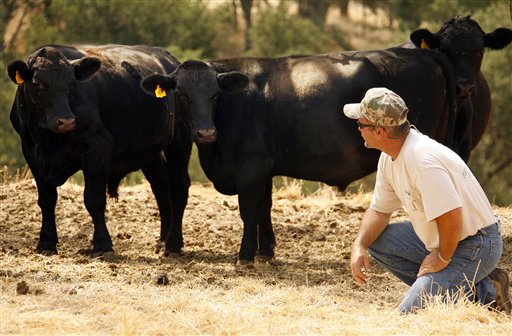April 29, 2007
Food Fight
Over at Grist, Gar Lipow has a long post on "Feeding the World Sustainably" that's worth a peek. Our current industrial agricultural system produces more than enough to feed everyone in the world. (The fact that people still go hungry is a problem of distribution and justice, not production.) But the current system is also totally untenable over the long run. Not only are we depleting water and topsoil at unsustainable rates, but food production relies much too heavily on fossil fuels. If "peak oil" hits—or if we decide that we need to lower our carbon use so that we don't burn up the earth—the industrial agricultural model just won't fly.
 Fortunately, there are ways around this. Lipow argues that different grazing techniques for cattle, goats, and sheep, along with no-till farming for row crops, would lower agricultural energy consumption some 60 percent. In some cases, food might even be cheaper. As for soil and water, it's still not clear that we can produce enough food for 9.4 billion people by 2050 in any sort of sustainable manner, even with a shift in techniques (At last count, our global footprint was exceeding the earth's biocapacity by some 25 percent.) But that's a topic, I guess, for another day. If you can't wait that long, see the heated debate in the Grist comments section.
Fortunately, there are ways around this. Lipow argues that different grazing techniques for cattle, goats, and sheep, along with no-till farming for row crops, would lower agricultural energy consumption some 60 percent. In some cases, food might even be cheaper. As for soil and water, it's still not clear that we can produce enough food for 9.4 billion people by 2050 in any sort of sustainable manner, even with a shift in techniques (At last count, our global footprint was exceeding the earth's biocapacity by some 25 percent.) But that's a topic, I guess, for another day. If you can't wait that long, see the heated debate in the Grist comments section.Now, things haven't shifted, in part, because oil's still incredibly cheap. If industrial farms were slapped with a sufficiently high carbon tax, they'd presumably change their ways pretty quickly. But that's not the whole story. Lipow points out that grass-fed cattle actually produce about the same amount of food per acre as feedlot cattle (once you factor in all the corn and grain needed to feed the latter). Grass-fed cattle use a fraction of the fossil fuel energy that feedlot cattle do. It's a more sustainable farming technique. And on the whole, it costs less. So why are feedlots so popular?
The obvious answer is that government policies favor the existing large feedlot ranchers. Obscene farm subsidies make corn and soy exceedingly cheap—and hence, lower the costs of feedlots. Large ranchers tend to have a good thing going, and see no reason to mess with it; instead it's easier just to lobby for regulations that favor large industrial farms. This is partly what Michael Pollan was alluding to in his fab New York Times Magazine piece on the madness of Congress' annual farm bill. Fiddling with that wouldn't solve all the world's problems, but it'd be a nice start.
